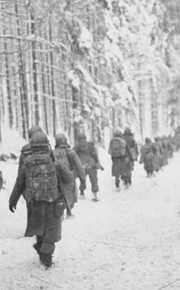
 The time between Hitler's December 16, 1944 surprise attack through the Ardennes Forest and December 26, 1944 -- when Patton's Third Army's 4th Armored's 37th Tank Battalion broke through enemy divisions that surrounded the strategic town of Bastogne, now fiercely held by the 101st Airborne under the command of General McAuliffe -- was only ten days.
The time between Hitler's December 16, 1944 surprise attack through the Ardennes Forest and December 26, 1944 -- when Patton's Third Army's 4th Armored's 37th Tank Battalion broke through enemy divisions that surrounded the strategic town of Bastogne, now fiercely held by the 101st Airborne under the command of General McAuliffe -- was only ten days.
The Third Army's role -- in the defeat of Hitler's attempt to split the Allied Forces and regain control ot the strategic Antwerp supply port -- began on December 19 with a meeting of Generals Eisenhower, Bradley, and Patton at Bradley's headquarters in Verdun. They met in a cold room reportedly heated by only one wood burning stove. Patton -- whose Third Army was at the time attacking eastward near a tributary of the Moselle -- left Verdun with orders to turn the entire Third Army 90 degrees and head north on the icy road from Arlon to Bastogne.
Along the way, in town after Nazi-held town -- Assenois, Bigonville, Burnon, Chaumont, Flatzbourhof, Martelange, Tintange, Warnach, to name just a few -- spear-headed by the Third Army's veteran 4th Armored Division -- battle after battle afforded little rest for battle-worn soldiers. Below freezing temperatures resulted in frost bite; deep snow drifts and freezing rain impeded the progress of men and artillery. Thick fog obscured enemy positions. Gunfire, exploding mines, rumbling tanks and the cries of wounded soldiers were inescapable. Air support from the 362nd fighter group was hampered by weather. Food was scarce. Inside foxholes dug with difficulty in frozen ground, soldiers died from exposure to the relentless cold.
From December 16, 1944 to the January 25, 1945 defeat of Hitler's deceptively named Operation Wacht am Rhein, in the Battle of the Bulge the Allies suffered between 75,000 and 80,000 casualties. The Germans suffered between 80,000 and 100,000 casualties.

